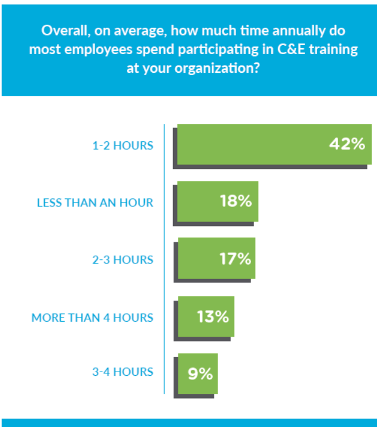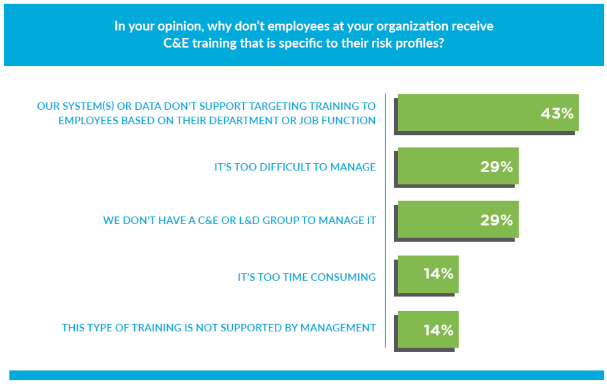Tags: Training
The purpose of this survey was to identify current trends, tools, and leading practices in the provision of compliance and/or ethics training programmes. In total, 125 compliance and ethics practitioners participated in this survey.
The survey received 125 responses from ethics and compliance practitioners, 75% of whom were based in the United States, with a further 13% being based in Europe. They represented varying sizes of organisation, with annual revenue from under $500 million (20%) to over $15 billion (18.4%).
Topics covered by the questionnaire included which employee groups receive training, how often, what technology and tools are used in the delivery of training, and how the pandemic has affected ethics and compliance training provision.
Who gets training and how much?
- A large majority (88%) of respondents reported that all employees at their organisations receive ethics and compliance training.
- Another 11% said only a subset of employees receive ethics and compliance training. This makes some sense for industries prominent amongst this set of respondents, including Metals and Mining, Automotive, and Industrial Manufacturing; these are sectors in which a given organisation is likely to have a diverse set of employees with wildly varying risk profiles in their roles.
- 85% of respondents said that employees receive ethics and compliance training specific to their role and risk profile.
- 11% said that no employees receive role-specific training, although all of these 11% did also indicate that all employees receive non-role-specific ethics and compliance training.
- The most common reason given for not providing role-specific training is ‘systems and data limitations’. Some respondents additionally cited lack of resources.
- 42% of respondents said that employees receive an average of 1-2 hours’ training annually. A total of 59% administer 2 hours or less on average.
- Just 13% of respondents indicated that employees receive more than 4 hours’ ethics and compliance training per year on average.
- 51% of respondents said their organisation provides ethics and compliance training to the Board of Directors (or other governing authority). 55% require E&C training for third parties.
What form does training take?
- There does not appear to be any correlation between the overall amount of training employees receive and the length of courses that are deployed. So, while most respondents (59%) provide two hours or less of training per year, they do so using a mix of approaches.
- Respondents tended to favour medium-length courses (defined as 16-39 minutes), with 66% of respondents incorporating these into their training programmes.
- Short courses (5-15 minutes) were the next most-cited type, identified as part of 62% of respondents’ programmes. Quick communications (1-4 minutes) and long courses (40+ minutes) were used by 43% and 40% of respondents’ organisations respectively.
- The results indicated that those organisations which employ a mixture of methods were more satisfied with outcomes.
- Those who rated their own satisfaction with their programmes as 8 or more out of 10 were deemed ‘Achievers’. This group were more likely to use a mixture of online and live training, and were also more likely than others to provide risk-specific training to all employees.
- 30% of respondents indicated that they have integrated humour into their training, while 22% have incorporated gamification. ‘Achievers’ were more likely to adopt these emerging approaches than ‘non-Achievers’.
Making use of data
- 58% of respondents said they capture and analyse data from their ethics and compliance training programme.
- This figure rises to 66% among ‘Achievers’ and drops to 47% amongst ‘Strivers’, the group who reported lowest satisfaction with their outcomes.
- A large majority of the organisations who do not use data analytics indicated that they would like to, amounting to 40% of respondents in total.
- 64% of those who capture and use data from their programmes said that they quantitative metrics. 9% primarily rely on qualitative information, while 20% cited both.
Impact of the pandemic
- 53% of respondents indicated that the pandemic hasn’t caused any significant change to their training programmes.
- Amongst those organisations where the pandemic did have an impact, the most common was a change in the topics covered by training (reported by 22% of respondents).
- While an overall majority reported no changes, certain sectors were disproportionately affected; for example, all respondents working in Travel and Leisure reported a decrease in the budget allocated for ethics and compliance training.
- Across the whole sample, just 14% reported a decrease in budget. Despite the pressure and uncertainty created by the pandemic, many organisations clearly recognise that this is no time to cut back on ethics and compliance efforts.
Conclusions
The findings of the survey indicate that the vast majority of organisations provide some form of ethics and compliance training to all employees, although a much smaller number ensure that all employees receive role-specific training tailored to their risk profile.
The respondents who indicated the highest level of satisfaction with the outcomes achieved by their programmes were more likely to use data analytics and to incorporate humour and/or gamification into their programmes. They were also more likely to use a variety of techniques, while those who reported lower satisfaction with outcomes were more likely to stick to one technique or delivery method.
This tells us that keeping training fresh and engaging through incorporating new techniques and alternating delivery methods delivers more satisfactory outcomes.
The impact of the pandemic on ethics and compliance training practices appears to have been relatively limited. We are pleased to note that only a relatively small number of respondents reported a decrease in the time or budget allocated for ethics and compliance training; this indicates a keen awareness amongst organisations that in times of uncertainty and pressure like that created by the pandemic, ethics and compliance risks tend to increase in frequency and severity, so it’s no time to be cutting corners.
The IBE recently published a Good Practice Guide on running effective ethics training programmes – find out more here. We are also running an online masterclass on effective ethics training – find out more here.


